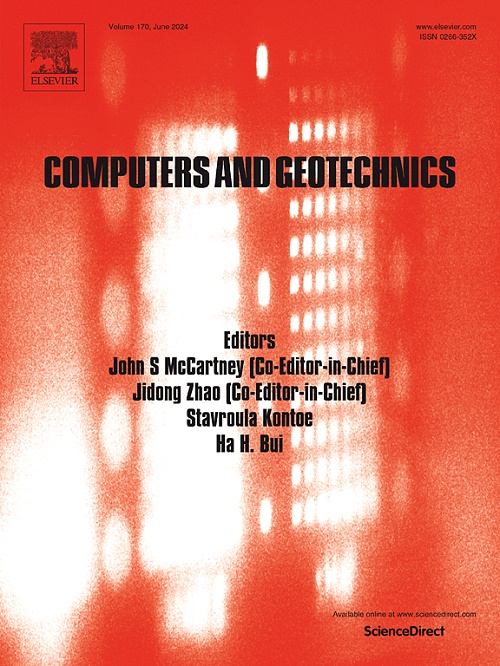冻土黏聚退化非正交弹塑性本构模型
IF 5.3
1区 工程技术
Q1 COMPUTER SCIENCE, INTERDISCIPLINARY APPLICATIONS
引用次数: 0
摘要
孔隙冰提供的粘聚力是影响冻土力学行为的关键因素,它不仅将土颗粒粘接在一起,而且与土颗粒共同分担外部荷载。鉴于黏聚力在建立冻土弹塑性模型中的重要作用,本文采用三轴抗拉强度(TTS)来表征黏聚力,并提出了由塑性剪切应变驱动的TTS退化表达式。通过将TTS直接纳入屈服函数,建立了冻土黏聚退化的非正交弹塑性(NOEP)本构模型框架。此外,引入了包含TTS的硬化参数,并将其与修正的屈服函数结合使用,以确定塑性应变增量的大小。在修正屈服函数的基础上,采用非正交塑性流动规律确定塑性应变增量方向。最后,结合Hooke规则确定的弹性应变增量,建立了冻土黏聚退化的NOEP本构模型。通过与三轴压缩条件下冻土试验结果的对比,验证了NOEP模型表征冻土应力应变关系的有效性和合理性。提出的本构模型更全面、准确地反映了冻土的外荷载响应,增强了对冻土剪切变形行为的认识,为寒冷地区的工程设计和施工提供了坚实的理论基础。本文章由计算机程序翻译,如有差异,请以英文原文为准。
A non-orthogonal elastoplastic constitutive model incorporating cohesion degradation for frozen soil
Cohesion provided by pore ice is a critical component influencing the mechanical behavior of frozen soil, as it not only cements soil particles together but also shares the external loads with them. In view the crucial role of cohesion in developing an elastoplastic model for frozen soil, this paper employs triaxial tensile strength (TTS) to characterize cohesion and proposes a TTS degradation expression driven by plastic shear strain. By directly incorporating TTS into the yield function, a framework for a Non-Orthogonal Elastoplastic (NOEP) constitutive model that accounts for cohesion degradation in frozen soil is developed. Furthermore, a hardening parameter incorporating TTS is introduced and used in conjunction with the modified yield function to determine the magnitude of the plastic strain increment. The non-orthogonal plastic flow rule is used to determine the direction of the plastic strain increment based on the modified yield function. Ultimately, by combining the elastic strain increment determined by Hooke’s rule, a NOEP constitutive model incorporating cohesion degradation for frozen soil is established. The validity and rationality of the proposed NOEP model in representing the stress–strain relationship of frozen soil are confirmed through comparisons with test results of frozen soil under the triaxial compression conditions. The proposed constitutive model provides a more comprehensive and precise representation of frozen soil’s response to external loading, enhancing the understanding of its shear deformation behavior and providing a robust theoretical foundation for engineering design and construction in cold regions.
求助全文
通过发布文献求助,成功后即可免费获取论文全文。
去求助
来源期刊

Computers and Geotechnics
地学-地球科学综合
CiteScore
9.10
自引率
15.10%
发文量
438
审稿时长
45 days
期刊介绍:
The use of computers is firmly established in geotechnical engineering and continues to grow rapidly in both engineering practice and academe. The development of advanced numerical techniques and constitutive modeling, in conjunction with rapid developments in computer hardware, enables problems to be tackled that were unthinkable even a few years ago. Computers and Geotechnics provides an up-to-date reference for engineers and researchers engaged in computer aided analysis and research in geotechnical engineering. The journal is intended for an expeditious dissemination of advanced computer applications across a broad range of geotechnical topics. Contributions on advances in numerical algorithms, computer implementation of new constitutive models and probabilistic methods are especially encouraged.
 求助内容:
求助内容: 应助结果提醒方式:
应助结果提醒方式:


